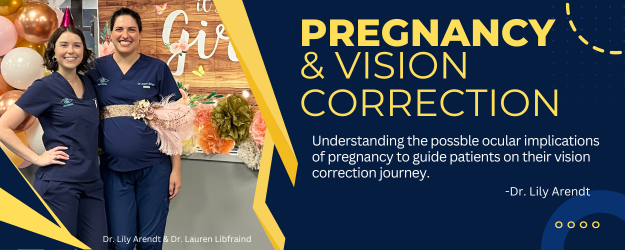Pregnancy and Vision Correction

By: Lily Arendt, OD, FAAO
Case Report: A 35-year-old male came to us for a refractive consultation.
OD: -3.00-1.00×017
OS: -3.00-0.75×006
When asked why he wanted surgery, he shared that he and his wife just had their first child three weeks prior! He quickly realized the inconvenience of relying on his glasses to help take care of his newborn. He was fortunate to work at a company who offered paternity leave and he wanted to take advantage of this time off to better his situation. We completed his pre-operative examination immediately following his consultation and he was scheduled for LASIK the next week.
In less than 10 minutes his LASIK procedure in both eyes changed his uncorrected vision from 20/400 to 20/15 OD,OS!
We’ve included this case to remind us that while LASIK and other vision correction procedures like SMILE and ICL are not indicated for the mother during pregnancy, the spouse doesn’t have to wait!
When it comes to pregnancy and the eye, there are specific changes to the cornea that may alter the patient’s prescription temporarily. These are due to mainly hormonal changes associated with increased estrogen and progesterone throughout pregnancy.1 For example, water retention in pregnancy can result in corneal swelling up to 16 microns in the second and third trimester.2 Corneal curvature can also increase one diopter on average due to the added presence of hormones temporarily weakening the corneal collagen matrix. Fortunately, these changes often revert to normal by two months post-partum, which is why we wait until at least 3 months post-partum before performing refractive surgery at our clinic. This allows patients to receive the most accurate treatment for long-lasting vision results.
What is the impact of pregnancy on dry eye? The proposed mechanism involves an upregulation of growth factors (TGF-ß1 and epidermal growth factor) that work against the lacrimal gland and alters its secretions.2 The elevated levels of estrogen and progesterone can also reduce the positive effect of androgens on the ocular surface, which we know help regulate the function of lacrimal and meibomian glands.3 Patients often report contact lens intolerance during pregnancy, which may be a combined effect of both dry eye and increased corneal curvature. These ocular surface symptoms often improve as the hormone levels return to normal.
A greater understanding of the possible ocular implications of pregnancy will help us guide our patients on their journey to vision correction. Many mothers make LASIK or ICL part of their family plan, choosing to have surgery before getting pregnant so they don’t have to worry about finding glasses in the middle of the night or having their children grab (and break!) their glasses. Vision correction is lifechanging and can only make the experience of parenthood easier. While we often think about the mother, when recommending vision correction to your patients please don’t forget the spouse!

